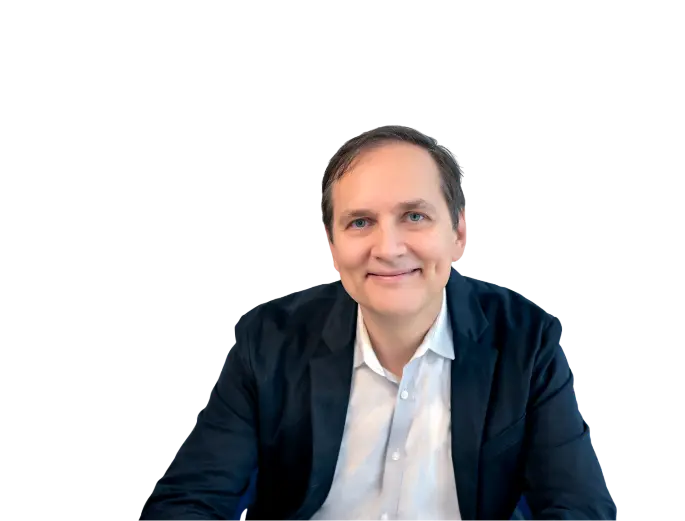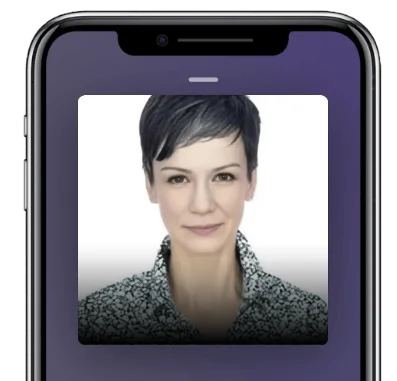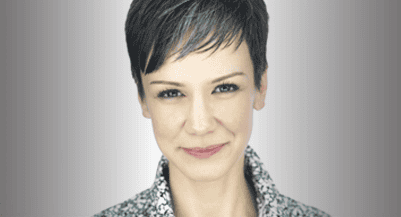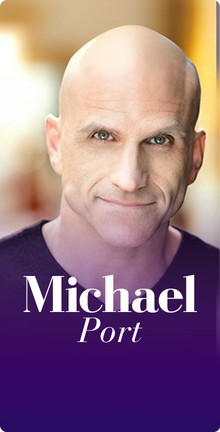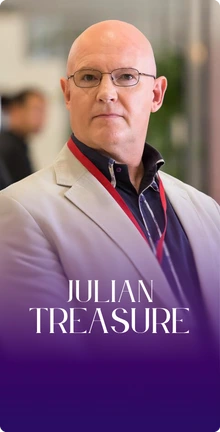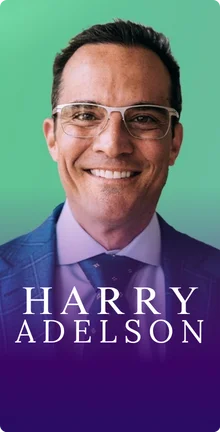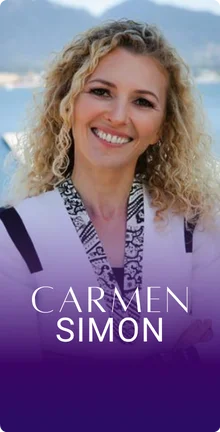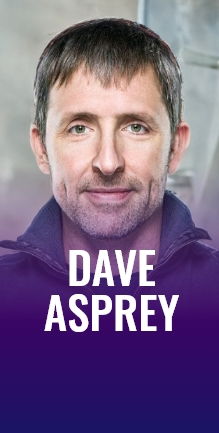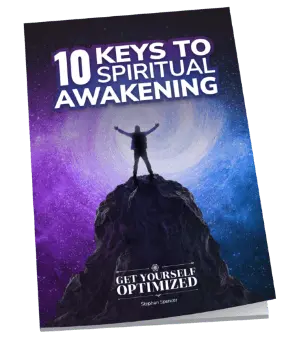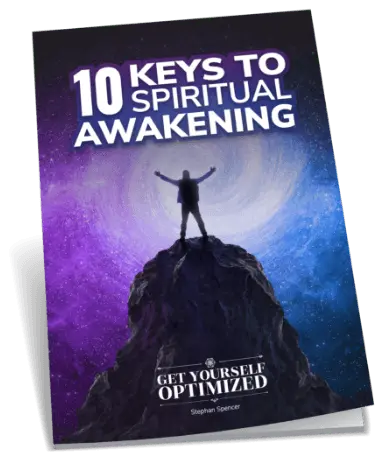In this Episode
- [02:38]What would be a good initial story or case example that Tamsen wants to share about taking speaking (or your life) to another level?
- [06:00]Tamsen came to a mantra: “check your dignity at the door.” She explains what this means to her
- [07:31]We learn how Tamsen starting her own business changed the role of speaking in her job
- [11:24]Tamsen would never suggest not rehearsing, she explains, but rehearsal takes many forms
- [15:42]Stephan thinks that personal stories are critically important because they humanize you for your audience, he explains
- [16:52]Does Tamsen show people a “before” picture from when she was 50 pounds overweight?
- [20:04]There are two approaches to sharing your big signature story, Stephan points out. He then talks about a stem cell therapy procedure that he and his wife, Orion, did together
- [24:07]Some of us are wired in different ways, Tamsen explains, and ties this concept to the idea of serving a greater purpose
- [29:12]When Tamsen is working with her clients, she’s incorporating things that she has learned that works, without squashing their personal style
- [30:07]Let’s talk about Tamsen’s concept of the red thread! She explains what the red thread is, and how she came up with it. She then goes into depth about how it works, why it works, and why you would want to use it
- [38:20]Tamsen realized that if she could get people to answer her set of questions, she could accomplish several things simultaneously
- [40:07]Stephan recaps what Tamsen has said about the red thread, including the five parts that it includes
- [42:23]Tamsen responds to what Stephan has been saying, pointing out one of the reasons that we’re often unsuccessful in getting our ideas across
- [46:25]Stephan takes a moment to rave about Tamsen’s skill in unfolding a story and connecting the dots
- [46:46]Tamsen explains the origins of the name “the red thread” that she uses to describe her concept
- [47:59]For Stephan, the catalyst for all the changes he made in his life was when he completed a fire walk
- [52:16]We hear Stephan’s thoughts about what Tamsen has just been saying about the moment of shift
- [53:16]There are still other people out there fighting the monsters we’ve already figured out how to slay, Tamsen points out
- [55:27]How can listeners work with Tamsen, and where should they go to find her?
Tamsen, it’s great to have you on the show.
I’m so excited to be here. Thanks so much for having me.
Yeah, for sure. I’ve already interviewed you on Marketing Speak. We talked to marketers about your frameworks and your different models and so forth. This is a little different of a show because we’re gonna talk about personal development, and speaking, and upping your speaking game in that context, up levelling yourself. What would be a good initial story or case example that you wanna share of kind of taking it to another level?
Of taking speaking to another level or…
Yeah, even taking your life to another level by using speaking. You have to show up differently in the world if you become a better speaker, a better presenter. You hold yourself differently. You kind of take on that persona. For me at least, all the speaking I’ve done, I’ve done thousands of speeches over the last two decades, I’ve become a much better human. I show up more powerfully and more intentional because of all the speaking that I’ve done. I’m just curious if you’ve had an example, either yourself or somebody that’s a client, or somebody that’s a client, or somebody that you know, a friend or a family member who’s used speaking in a powerful way.

I’ll start with the story of my own, actually. That’s kind of unusual place where I earned my speaking chops as it were, and that was as a Weight Watchers leader. Some folks know about me, some folks don’t, but I used to be 50 pounds overweight. I’ve now kept that off for 20 years and two kids. The kids were the hardest work. In addition to my full time job as a marketer which I was for 20 years, as a way to keep myself honest, but also to pay forward something that I ended up being so transformation for me when Weight Watchers asked if I would become a leader in my free time, I said yes. Practically I wanted to help keep the meeting open where I had lost weight but I also really just, as I said, wanted to give back. When you’re a weight watcher leader what you’re responsible for is not just weighing people in when they come in. But you’re given a topic every week. Weight Watchers is very clear about these as leaders at meetings, not teachers of a class. My job was every week to take this topic. In the 30-45 minutes that I had, my responsibility was really to permanently change as best I could someone’s thinking or behavior about that particular topic. Maybe it was activity or maybe it was drinking water or maybe it was positive self-talk, it could be all sorts of different things. I will tell you honestly, I think there’s basically about 16 topics and we just rotate them through. But that also became a real creative challenge for me.
By the end of the 13 years, by the time I decided to retire as a weight watcher leader, I did the math one time, and I ended up doing about 3000 presentations. I say honestly that so much about what I know about speaking, about people, about using speaking to change people, I learned at Weight Watchers. Huge amount of what I learned there I applied to my marketing jobs and became a better marketer as a result. In more recent years, I learned what I learned there to my own speaking but also the work that I do with other speakers because it ultimately comes down to how do you overcome resistance in someone else so that they can find an idea as irresistible as you do. There’s no better training for me than the week in, week out, like, “Alright, you get up to five chances a week to figure out the best way to do this.” Then you’d have to start doing it all again with a different topic the next week. What I really learned was all sorts of stuff. Not only what were those basic components that were required an informational stand point. What did people have to hear in what you say to be convinced. Also, learning for instance you can’t make anyone agree or do something but you can only create the space for agreement. How do you do that as a speaker?
Learning what was more powerful for me as a presence in front of other people. I had this mantra that I came to finally. What I used to say to myself was, “Check your dignity at the door.” What I meant by that was just anytime that I try to be this authoritative person, I just didn’t connect with people. When I was this dork goofball, geeking out on science and behavioral economics, that’s what they loved. They loved that. When I was just, “Here is a ridiculous thing. Here’s the thing that happened.” The more that I didn’t think about that, the better I behave. I’d say that the final thing that it did for me was just, man, there is no question you can ask me that doesn’t throw me. I became extraordinarily comfortable with Q&A as a result of that experience. It’s one of those reasons why, even now, I make Q&A interaction with the audience a huge part of my speaking and increasingly more and more because that’s when I’m most comfortable. That’s what I learned from Weight Watchers. That’s a personal example.
I love that.
Yeah, that’s me. That’s my Weight Watchers part of it. I can talk about Weight Watchers all day. Not because of the plan itself, it’s less about that, and much more about all of the lessons of life, and learning, and all sorts of other stuff that came along with it.
Yeah. Be yourself is kind of one of the key messages here. If you’re a dork then just embrace it.
You dork. As you know, I started my own business about two years ago now. When I did that, that meant that for the first time rather than speaking as part of my job to help other people understand what it was that I was doing in my organization or as marketing, now speaking became a third of my income. That’s part of my income, part of my job now is to speak, to be a speaker. As a result of that, because I felt for my own sake I wanted to invest in that. I spent a lot of time and a lot of money kind of really diving deep into performance, content, and all of that. I found that I was able to communicate in more keynote areas, two parts of my personality that I thought were important and I knew worked well from Weight Watchers which was smart and interesting, not because I’m smart. I very much like to make the audience feel smarter as a result of the talk. It’s for all the reasons why I never shied away in my Weight Watcher meeting of talking to them about some pretty complicated cognitive science and behavioral economics stuff because they could handle it and because they knew that I thought they can handle it, they could, and then they walked away just much better armed with more information. I always loved that kind of stuff.
That’s a thing that I really worked on the last couple of years to figure out how do I become a better storyteller. I spend a lot of time studying screenwriting and novel writing and diving into the work of Shawn Coyne, and Blake Snyder, and Ken Miller. How do short form storytellers in other aspects, how did they make the information interesting? I really kind of got that piece down. But then I kept thinking back to the Weight Watcher meeting, that kind of speaking was so much fun for me. I love those Weight Watcher meetings. Mind you, I was getting paid crap to do it. I wasn’t doing it for the money. I had a full time job. But I was doing it on Sunday mornings, [8:00] on Tuesday mornings, [5:30] on Thursday nights, all this extra time. I was doing it because it was fun. What I noticed over the last year and a half as I was working on all my performance and all this other stuff was that in mastering the other things, the fun part went away. The content wasn’t fun for me, the performance wasn’t fun for me, so it wasn’t fun for the audience. I got to a point where it was just so exhausting for me to speak because it wasn’t fun. Like, “God, why am I doing this? It’s not fun.” My consulting is fine. I could survive just by consulting but there was a part of me that does like to speak. I was like, “How do I fix this?”
This year has really been the year of getting the fun back. I don’t mean to be a broken record with this but I really went back and said, “Well, what made Weight Watchers fun? Why was that so much fun?” I realized it was because I had gone to a point of comfort with these topics. I never repeated a meeting twice. There are definitely leaders who would be like, “Oh well, this is the topic. This is the meeting where I do X.” I never did that . It was a point of pride for me. It was a constant challenge like, “Okay, great. Here comes the activity again. What are we gonna do this time?” But by having to figure out a new way to do it every time, it did a couple of things. One, it made sure that I had to know these topics inside and out, any way you could look at them. Push them, pull them, stretch them, shrink them. But it also meant that on a spur of the moment I could change course but still be talking about something in a way that I was familiar with, and I was comfortable with, just because I spent so much time researching it and thinking about it, and talking it through in one way or another somewhere else.
You weren’t rehearsed, you were just a natural at it after dealing with so many times and so many different ways.
Yeah. That’s exactly right. It’s a different kind of rehearsal. I won’t ever say don’t rehearse because I completely believe that rehearsal is the key to a masterful performance. But I think rehearsal takes many forms. A lot of times, I’m talking to clients and they’re like, “Ugh, I don’t want to rehearse.” Well, I still believe that running through your content as you intend to do it at least several times is always good. Something that works well on paper doesn’t always work well when you speak it. The other thing I say to people is that rehearsal, I rehearse every time I records a video every week. I do a weekly video podcast and they are always eight minutes or less. I gotta tell you, so many of those little bits have ended up in talks because by recording the video, I figured out the best way to say something. Now that’s the way I say it. I rehearse by having these conversations with my clients. A topic will come up, a question will come, or a question continues to come up. I’ll keep experimenting as I’m working with them on what’s the best way to explain it. What would be a better example that was another way to explain it. Until eventually what ends up in my talks is very well rehearsed but it’s because the way I’ve come to explain something over time after lots and lots of trial and error and figuring out what works with actual people. There’s always a point where I’m trying to figure out myself first. Even in my videos, I’ll sit and I’ll write out my Red Thread statements as I call them. I don’t script those videos but I know the points that I’m trying to hit and in what order. I have done it in as little as one take and as many as 72. Just the right combination though I have to tell you that most recently, I’ve gotten better and better about going, “You know what, that one’s close enough.” I’ve trumped down the number of takes per video.
It sounds like you have fun when you’re taking these videos even if it’s just by yourself.
Sometimes, yes. I apologize for any of my neighbors who may occasionally hear a loudly voiced curse word. Yeah, yeah. I’m having fun because I’m figuring out and I’d be like in the middle of this great thing, and then all of a sudden I will just come to a point where I stumble over what I’m saying so badly that I can’t recover it. I don’t try to edit out my occasional stumbles, I’m human. I don’t want people to think that they’re totally scripted. I do get that question from people like, “Do you script those?” I’m like, “Ah, no.” But there are certain times where I just absolutely muff it and I’m just like, “Argh.” Like I said, loudly voiced curse word that erupts from the apartment. Because usually, in the last two seconds of the video, after I’ve gotten this perfect art and then like, “Dang it. Aargh.” But I do have fun. That’s what I have been trying to do this year, get the fun on stage too. I started that with the content. I know what I’m trying to say just like my videos. My videos taught me a lot about this too. I know what I’m trying to say. I have worked out a couple different ways to say it. I’ve worked out what feels like by and large the best way to say it, though a word will be different here or there from time to time. But then I really started to figure out how do I get it to feel more like a Weight Watcher meeting to me. That meant asking a lot more questions and honestly bringing a lot more of my personal stories that I just-for a lot of time, I was uncomfortable talking about them because I didn’t immediately see how to make them relevant to what I’m talking about. But so often now, what I’m talking about is best illustrated because sometimes these examples from my Weight Watcher meeting were just so crystal clear that it’s a great way to articulate something. Most people who see me now, it’s always a surprise for them that I used to weigh 50 pounds more. That already gets people into a change of state about me. But it’s been really interesting to slowly, each year, kind of figure out what’s the next thing, what’s the next piece that I’m trying to bring into my speaking. In certain ways, this year is about actually returning to where I started but with the benefit of all that I’ve learned in between.
I think personal stories are so critically important. It humanizes you. It builds relatedness with the audience and they feel like they can connect and take that journey with you. They’re listening with instead of a critical voice thinking, “So what?” They’re thinking to themselves, “Me too.” I had a problem where I wasn’t 50 pounds overweight but I did not look the way I wanted to look. I can totally relate to you on that level. In fact, the reason why I started my podcast has a large thing to do with the way I used look about 20 years older than I actually was. It was all kind of unconscious that I let myself go in that way but then people see the before photo and like, “Holy cow, Stephan. I can’t believe you used to look like that.” They would be shocked. Do share your before photo of when you were 50 pounds overweight?
I do. Because it’s one of those things where people don’t believe me unless I show them. I think it’s an important aspect of changes too. I know that I can just describe that for people but usually what they say is, “I can’t even imagine.” It’s useful to have before pictures that I put up on a slide if that’s the case, then I’d put them up just so people can see it.
Yeah.
It’s funny, again, I go back to the course that that was the case. I knew that even from Weight Watchers, if I didn’t say within the first few minutes of the meeting why I had credibility to stand there, then new members walking in would be like, “Who’s this skinny thing talking?” I knew it because I can see it on their face. I would actually call it out. I’d be like, “I know. I know. You’re saying to yourself what’s this skinny B doing up there talking about this? Well, let me tell you.” They love the fact that I just went right after what was in their head and that was it. That was dispensed with, then they knew I had been in there with them. What I don’t love is when people use personal stories manipulatively just because it makes them relatable. I see this working with clients. I see it particularly with people who are wanting to put together TEDx and TEDx style talks. They have this image in their head that they’re always anchored in some kind of deep, wrenching personal story. What I’ve seen a little too often is someone tells this deep, wrenching personal story, and then it’s completely unrelated to the point that they’re trying to make. It’s kind of like, “Why did you say that?” Thing that I’m really ruthless about is there has to be a legitimate reason why that story is in there. If it’s not a legitimate reason why it’s in there, I personally am not gonna put it in there.
For example, I have a story that I know people really like of mine and they find it really powerful but it really hasn’t been until recently that it has truly had a reason to be in a talk. I was running the Boston Marathon the year it got bombed. That’s actually less interesting to me and seems to be less interesting to people than the fact that two weeks after that, I put my number back on and finished it by myself. It’s actually that piece of it that I went back and finished it by myself that now has a reason to exist in at least one of the talks that I give because I spend a lot of time talking about what makes ideas irresistible, or as I said before, how do you overcome resistance to making an action that you want or need to make. Going back and finishing that race, even though it was without any of the glory that should have been there if the bombing hadn’t happened, it’s an illustration of that. How did I move through the anger and the guilt of not finishing and being angry about not finishing and then being guilty about being angry because I wasn’t hurt. I was too damn slow. I was 5 ½ miles back. I think that stories have to serve a very specific purpose. They have to be tied to what you say because otherwise people will enjoy them, they might feel inspired by them, then you almost waste the power of them. If you can tie them to the point that you’re trying to make then they’ve got their own momentum behind them. Why not harness that towards your point?
I guess there are two approaches to sharing your big signature story around losing 50 pounds or for me essentially going back in time like Benjamin Button, getting younger. Have you seen my before photo?
I haven’t. No. I’m really curious, Stephan. I wanna see it.
Oh my god. You can go to getyourselfoptimized.com and look on the about page. Yeah, it’ll blow your mind.
Alright. That’s awesome.
Not every talk that I do—and I speak a lot. I’ve done keynotes recently. I do lots of panel sessions and workshops and things like that. Not everyone is appropriate for me to share my before photo. Most of them are not, actually. I’m teaching something about some aspect of SEO and how to get Google to bend to your will sort of thing and it’s not really appropriate for me to share that before and any kind of story around that because it’s not relevant. It won’t help them. I’m totally on board with what you’re saying. I used to shy away from sharing my before photo and my story because I was embarrassed. I was thinking like, “Ohh, I really don’t love that when you Google my name, some old versions of me are showing up in the images results on the first page. I wish I could get rid of it.” Oh, actually no. I know a few things about SEO. I think I’m going to push that off of page one and then I’m thinking no. I probably should just leave it because this is part of my story, it’s part of who I am, and it’s part of the value that I bring in the world being that vulnerable and open. I was so vulnerable that four weeks ago, I did stem cell therapy. It’s on one of my episodes on the show was with amazing stem cell doctor, Dr. Harry Adelson who keynoted at the last Bulletproof conference.
My wife and I go to his clinic in Park City, Utah about a month ago and we get the full monty, the whole procedure, the whole thing including I got the P shot, my wife got the O shot. You can guess what the letter P stands for. If you think about it. If it’s for men only and then the female version is the O shot. We got stem cells injected everywhere, places that hurt, places that didn’t hurt, places that really didn’t need it because they were awesome already. It’s a really amazing experience. I was afraid of needles so I’m like, “Just put me out before the whole thing. I don’t wanna be awake for the procedure.” Dave Asprey—the Bulletproof coffee guy, another past guest on the show—he was doing a Facebook live, completely awake during the procedure while they’re harvesting stem cells from his bone marrow and from his fat. I think he passed out a few times during the Facebook live. Just temporarily for a few seconds and he’s back. I’m like, “Put me out for this.” But the first thing I did as soon as I woke up within five seconds, “Where’s my phone? I wanna take a video and I wanna share.”
I was covered in bloody mass on my face because they take PRP, platelet-rich plasma from your blood, as well as stem cells which they had harvested from my fat and my bone marrow. That was microneedle injected into my face, so I looked like, I don’t know, somebody had dragged my face along the freeway for a while. I’m like, “I don’t care. I’m just gonna do a video.” My wife was there with me and she had gone through the procedure a couple hours earlier. She looked pretty similar to that but I had just woken-up and I’m doing a Facebook video, sharing my experience with people. Even just like a couple years ago, I would not have done that. Having that kind of vulnerability and openness is so critical. You build that relatedness so you actually impact people. Take them on that journey. You really do change their lives.
Yeah. I think some of us are wired in such a way that it’s no question. You’re like, “Sure. I’ll tell you everything.” Some of us are wired in a way where it’s just, “Okay. I need to see the reason why this is gonna be useful but once I see enough that it’s this useful to talk about this piece then okay. Yeah, I get it. I get it.” As I said, as long as it’s tied to the greater purpose, not of making me look good, that’s not enough of a reason for me. It’s not about, “Hey, look at what you did.” It needs to serve the idea, it needs to serve the point. If it does that then that, for me, that’s the reason to include it.
Yeah. What you said there about looking good and conversely not looking bad. That just needs to be dropped from the motivations for I think all of our listeners when they’re doing whether it’s a Facebook live or it’s a speech on a stage or it’s a TV appearance or just running your own little meeting and having a handful of people in a room. Just get rid of that. That ego drive to look good or to not look bad because that doesn’t serve anybody including yourself.
Right. That’s where my ‘check your dignity at the door’ piece came in.
Yeah, it’s great.
That was my reminder to myself. Just don’t try so hard. In fact, just being fully connected and fully present ended up being more useful. Over the last two years, I was really trying to work on my speaking, it became a source of great frustration for me. Why couldn’t I reconnect with that? I would ask multiple people, this so easy for me in the Weight Watcher room, what’s different about when I get up on stage? Why is that not translating? In my own head. Because it wasn’t that I was doing it and I wasn’t connecting, I just wasn’t doing it. That’s when I took a hard look at what I was doing. I was like, “You know what, it’s because I’m not preparing the content the same way.” I very much believe that the only way I was through it, I won’t tell somebody to do something. I wouldn’t advise somebody to do something if I haven’t tried it myself. A lifelong believer of ‘what’s good for the goose is good for the ganders’. If I’m not willing to do it, if I’m not willing to try it, I’m not gonna tell you to do it. I think it’s best if I’ve done it then I’m in a better position to help you understand what that experience can be like which is why I wanted to kind of say okay, I’m gonna try different ways to put keynotes together in addition to my own working out for myself, what’s the process that really works for me, what works for my clients and the TEDx speakers.
The one thing that I wasn’t doing was mimicking what I knew from 13 years of speaking worked really well which was not having it so tightly scripted on paper first and then getting it on my feet but actually getting the words solid around the concepts. And then if I needed to, then committing that after the fact to a script so that I could go back and reference. It’s really interesting to me that this is a process of rediscovering, reconnection with what works and being willing to say, “Okay, I see the value in some of these other approaches of putting something together.” I’ve got 13 years of muscle memory around presenting a certain way. I’m sure if I spent 13 years with fully scripted talks that I rehearsed fairly well as scripted, they will be equally comfortable to me, maybe. But I think I’d miss the fun, frankly, of not knowing exactly what the audience is gonna say in response and being able to play in the moment with what somebody says or does. Being able to have that level of flexibility and ability to improv in the moment because when I write my talks, I’m not funny, just not. But those moments where I can play, those moments of improv in between those pieces that I know really well, that’s when I’m actually funny. But it was never something I could capture and that was frustrating to me too. I’m like, “Why can’t I be funny on stage?”
Is because I was trying to script every moment. Don’t get me wrong but knowing what you’re saying and finding the best way to say it is absolutely key but the real eye-opening thing for me is that there needs to be more than one way to get there for people and people who work with speakers. If you’ve got listeners who are thinking about what’s a good approach for them, I would highly recommend the best coaches are the ones that can change their approach to suit you, that have multiple ways of getting to the same conclusion. I’m thankful that I work with people who are able to do that but blowing it’s back up from the content up was definitely me going back and saying I wanna make this feel like it did back in the meeting room, back when I was a Weight Watcher leader.
The best coaches are the ones that can change their approach to suit you, that have multiple ways of getting to the same conclusion. Share on XWhen you’re working with your clients or speakers that are speaking at TEDxCambridge that you oversee, you’re incorporating stuff that you’ve learned that works and you don’t squash their own personal style. You let them work within a certain framework, so they’re able to be funny if they’re funny in the moment but they’re not if it’s all scripted, or if they kind of have a certain way of showing up on stage that’s a little unusual in the way they stand, or the way that they interact with the audience, whatever, but it works. You’ve developed this framework that works for everybody, the Red Thread.
Yup.
Let’s talk about Red Thread. First of all, you said earlier that you wanna teach stuff that you’ve done yourself that you found works. The Red Thread was something that you came up with yourself through trial and error, through your Weight Watchers experience, how did this come about?
That’s a yes to all of it. It came about, first and foremost, with TEDxCambridge. While I retired from my executive producer role at the end of the last year after the last event, that absolutely is where it started because I was in a position where I had just started my own business. I already had a couple years at TEDxCambridge under my belt but I started my own business and I was in the position where I gave myself to challenge of coming up with a new way of getting people to the best version of their idea and a narrative for the talk that felt like a story even if it wasn’t one. That didn’t use anybody else’s IP. I wanted to create something from whole cloth. At this point, now two years ago, I had 20 years of marketing and brand strategy and message strategy under my belt. I had about 15 years as a speaker under my belt.
I already had two years as a TEDx executive producer and I also had those 13 years of Weight Watchers. The process to come up with the right thread-ultimately, at the highest level, it was me trying to reverse engineer what I had learned by osmosis as a Weight Watcher leader that I then turned, and then I took what worked in the knitting room and I applied to my marketing jobs. I just kind of developed overtime this innate sense of the messages worked when they had certain stuff in them. But I hadn’t really figured out what those things were. It turns out that in the research to figure out how to be a better storyteller, remember that was a thing that was on my list a couple years ago, I took this deep dive into story structure and storyboarding as novel writers, TV writers, and film writers. I had some inside help of course because my sister happens to be—I don’t know if I’d mentioned this the last we spoke—now an Emmy-winning screenwriter and Writer’s Guild Award of America award-winner screenwriter.
Wow.
Yeah, she’s awesome. She’s one of the writers and producers of the Handmaid’s Tale and has done all sorts of other writing credits but that’s what the awards came from. I was trying to figure out, well, okay, story structure. I’ve been reading about it for years. Of course, Nancy Doroteo has done a wonderful job talking about it but my experience in business was that typical story structure; rising action, falling action, calling to the quest, the hero and the mentor and all this, which was way too freaking complicated for most business people. You start to talk to them about these things and would glaze over. The other thing that was really frustrating to me was just because you know the elements to the story, didn’t mean that you knew how to build one. This is the puzzle that I wanted to fix. I wanted to fix it because I wanted to be a better storyteller. But I also knew I needed to do it because I needed my TEDx speakers to be better storytellers too. I started playing around with okay, rather than trying to focus on what do you put in each of the acts of a classic story structure; act one set up, act two conflict, act three resolution, which is where most advise starts, I said maybe it’ll become clear what I should put into the act if I actually focus more on what the end points of those acts are.
Set up, what is the set up about? Where does someone start and where do you get to as you break into act two? I was like okay, how does that relate back to business? How does that relate back to what I did in the Weight Watcher meeting room? I was like oh, I know. I will get somebody start on a journey is that if they knew at the end of it they would get something that they really wanted. I was like if there’s an irresistible outcome, then that would get them to at least start. This is something I’ve seen over and over again in the meeting room. Obviously in the meeting room people wanna lose weight. There’s a pretty universal goal there so that was obvious. In my marketing jobs I’ve seen the same things. Companies would wanna differentiate or they wanted to raise donations or they wanted to do XY or Z. There was a thing that they wanted. That was the beginning of act one. I didn’t have to really actually figure out what went in the middle yet. I just need to figure out where did act one need to end. A classic story structure, act one ends with the introduction of a problem. I started to think back to marketing, Weight Watchers, and my own experience, it’s like well, it’s not just any problem though.
It’s not a problem that people already know about because—back to Weight Watchers—plenty people know what’s getting in their way of not achieving their weight loss goals if that’s something in their mind. It’s not the awareness of the problem that’s the key, they’re actually something specific kind of problem that gets in the way. I was like if I can identify what that specific kind of problem is, then we’ve got something. I could ask anyone, “Tell me what your audience wants that your message can help them get.” Most people can answer that question. Then I could say, “Alright, tell me about what’s getting in their way.” Tell me what they think is getting in their way. But then here’s the next blank I want them to fill, “What do you really think is getting in the way? What is the perspective that they have that’s blinding them to the path that you see towards getting to that goal?” That was the second blank and so they have called the problem because that’s how you got into act two. Now the act two of course is all about the conflict and there’s a midpoint in all of this. There’s this point in act two of storytelling structure where there is something—they call it the point of no return, it’s the climax, whatever. It’s the point at which the hero of the story can’t turn back for one reason or another or there’s a moment where they decide whether or not that’s it or not. I was like okay, well, did that validate in my own experience what I had seen when trying to move people along in a message whether that was a meeting room or a marketing.
It was like yeah, there were times when there would be this one piece of information that when delivered all of a sudden now they moved themselves to the next step, they’ve moved themselves to doing something different.” I was like okay, that’s gotta be the third blank that we have to fill. We have to fill the equivalent of the midpoint. The thing that people can’t sometimes hear. I started to call this the idea. Some neutral piece of information, some incontrovertible truth that made this problem that we have introduced impossible to ignore. But also, if we didn’t do anything about the problem, it would put the goal in jeopardy. I was like, “Goal, problem, idea,” interesting. Now I’ve got three blanks that I think that I can get people to answer fairly easily, to fill in. By the way, once I knew what those things were, it started to be pretty clear,”Well, how do you fill in the space in between them?” Because then, you’re just asking yourself how do I get someone from the goal to the problem? How do I get them from the problem to the idea? And then the cool thing was, of course, from the idea, the midpoint, the thing would break into act three, the thing that would take it to the resolution was what’s the thing that they’re going to do different? What’s the thing that they decided to do or need to decide to do differently that created the fourth blank for people to fill in, and that’s what I referred to as the change. What’s the high level shift in thinking that needs to happen in order for someone to achieve that goal, resolve that problem of perspective but still stay true to that idea that’s at the core of it all. That was the change. And then the fifth thing was what are the specific actions that people would take?
That’s just mostly because in particular, the talks, and you and I talked about this in our previous podcast together. When someone’s got the seven steps to SEO success, well, that’s great. Those are the actions but we have to figure out overall what’s the big shift that they’re doing. Once I reverse-engineered my own experience against story structure and knowing based on my experience, people actually couldn’t answer as far as questions go. I realized I had this set of concepts that if I could get people to answer those questions, I have accomplished several things simultaneously which was awesome. I had probably first and foremost really pulled apart the conditions that created the idea for somebody in the first place. We had basically been able to figure out what are these concepts that actually create the conditions for agreement. Like I said before, you can’t tell someone to change but you can create the conditions for change. I realized that these things that I’ve come up with, I knew that they did that because I also knew from the research that I had done all my years in both Weight Watcher leader and marketing when it comes to what makes people act, and motivation, and all these other stuff, that it was relying on known science about how the brain works to get people to flip how they’re thinking about something.
Basically, after that, it was just a matter of, “I wonder if this works like this.” Then I sort of started using it with the TEDx speakers because that was all pro bono. I wasn’t getting paid to do that. It turned into my lab. I was like, ‘Let’s see how this works.” It worked like a freaking charm. The free pricing side was because these blanks were based on story structure, if people filled in their statements and they’d put those statements in that order in the course of the talk, they also had this high level outline for the talk that felt like a story. Starting that two years ago, it was really just a process of getting clearer, and clearer, and clearer about how to make it easier, and easier, and easier for people to fill in those blanks. Then the last thing I need to do was name the damn thing. That’s where the Red Thread came in. It was a really long explanation but that’s the history of it.
That’s great. You’ve taught us a lot about what the Red Thread is and how the framework works and why it works and why you’d wanna use it. It’s like a story art; there’s the goal, there’s the problem, the idea, the change, and the action the person would need to take in order to achieve their outcome that they’re after. A lot of times, people don’t recognize the true problems so you can articulate the problem in that story art or in the Red Thread in a way that gives them an aha or some sort of insight because there’s the spoken problem, the obvious problem, but there’s also the unspoken problem that they don’t wanna tell you about. For example, with me and why I looked so old for my age a decade ago. I was married to a woman who is 16 years older than me.
Unconsciously, I was letting myself go and looking older because my fear was that I would get mistaken for her son. That really was, I think, the unconscious impetus for me to look older. That’s the unspoken problem. I don’t volunteer that information usually. We’re divorced now and I’m happily married to my soulmate now, but wow, what an embarrassing thing to share, “Yeah, I was married to somebody 16 years older than me.” That’s fine for a woman married to a man 16 years older but culturally it’s kind of taboo for a man to be married to a woman 16 years older than him, whatever. I got over my fear and the discomfort, I guess, with sharing that. That’s the unspoken problem that I had. Spoken problem that’s easy. I’m just letting myself go back in the day. I looked older than my age. The unspoken problem but then there’s the unknown problem which I guess, actually, I did not at the time realized that that’s why I was letting myself go or looking the way that I did was because of that fear.
This is why I love that you just said that because this is where I love to just home in with speakers to say the reason why we’re often unintentionally not successful with getting our ideas across is that we forget that we had these little realizations all the way along. We think that a great idea is found, but great ideas are built. They are built little piece by piece by piece and the moment where we think we “have an idea” is simply the moment where the last piece falls onto place. Each of us can think about this. I’m curious if this resonates for you with the change that you may have in your life. But if you think about the hardest change you’ve ever made in your life, whatever that was, maybe it was the end of the relationship or beginning one, or maybe it was the change in health, starting a business, whatever it might have been. Everybody I’ve talked to so far has said to me that of course it was a lot of work but there was one moment when suddenly the decision to act became easy or the very least when not acting became harder than acting. That moment is what I’m obsessed with. What is it that creates that moment?
What I realized is that these goals, these problems, these ideas, that’s this magic combination that when they’re set up just the right way, they create this tension that pop you over into a change. As speakers, because we forget stuff happen, we try just to share the idea as a complete thing, we don’t realize that we actually have to give people the pieces so that they can put it back together in their own heads and come up with the same conclusion. We have an advantage though because you may not have thought about it in that way yet, but because now you’ve come to the conclusion, you can go back and say, “Ha. Now looking back on it, I could say that I thought it was X but now I can see it was because I had an incomplete perspective…” You were focused more on, let’s say, kind of matching your partner than matching yourself. That’s the way for you as this already changed person to go back and put a name on the problem of perspective that you’ve had. There is probably some core fundamental belief that you have, Stephan, about being true to yourself, or happiness, or the way that insides match outsides, whatever. There’s some core fundamental belief to you that once you put that against—consciously or not—put it against that problem of perspective, made it impossible for you to continue to say, “Wait a minute, why am I matching my partner when I believe this? I gotta do something that’s true to me.”
That’s where we have this advantage as speakers and people with ideas is that because you have reached this point, we can turn that curse of knowledge into a blessing because now you know what the elements are, you can take this now informed perspective on, “How do I describe this in its most powerful way to somebody else so they understand exactly what that was.” By doing that, you can recreate the conditions for people in a very short amount of time that allows you to have that idea, that come to that conclusion in the first place. It may have taken you however many years to get all the pieces in place but well-articulated, you may still need to support it but you can lay the groundwork for that shift for someone in a minute or less. Just by saying, “You want to live a long, happy life, but the problem is if you’re matching your partner rather than yourself, there’s a problem there. Why? Because you are the only one that can live your life. That’s gonna create some kind of gap which means that you’re gonna wanna change and what is that change?” Now, as a speaker, you can say, “These are the actions you can take.” I know that you don’t speak on that, Stephan, but just as an example.
That’s so cool. I love how you unfolded that whole story into something that’s relevant to everybody. That’s so powerful. You connected the dots. That’s where I know the name the Red Thread comes from, but you wanna quickly share for our listeners who aren’t familiar with the origins of the name?
Sure. The more I work on it, the more that I realize that I kind of stumbled into a perfect name for it. The Red Thread is used as a colloquialism in a fair amount of Europe to mean the through line, the thing that makes things make sense. It comes from the Greek myth of Theseus and the Minotaur. The Red Thread is actually the way that Theseus traced his path to the Minotaur, the monster that he had to slay in his labyrinth so that he could retrace his path on the way out. For me, the Red Thread method as I’ve developed does very much the same thing. It allows you to kind of follow the path back to—you’ve already slayed the monster. That’s the thing that you’re talking about and you’re trying to teach other people either how to do it or why it’s important to slay the same monster. But in order to do that, you actually [00:52:56] follow that same path. That is the reason why it’s called the Red Thread.
Awesome. When you were saying earlier you’re obsessed with finding out that one moment where the shift came, where the point of leverage or the… what’s another word for it?
It’s just like when the hard thing becomes easy, not that it becomes without work, but it’s just that switch flips.
It was, for me, the catalyst for all these changes that I made to do my life reboot and look the way that I do now versus the way I did a decade ago, it was a firewalk. It was literally a firewalk, walking in 2000 degree hot coals at Tony Robbins’ event, Unleash the Power Within. That was the moment. When you were describing you’re obsessed with finding that moment, I knew exactly that moment that you were talking about in my story. It was that 10 seconds or 20 seconds when I walked on the hot coals in my bare feet. I didn’t get burned, I didn’t get blisters or anything, I’m like, “Wow, if I can do this, I can do anything.” I’d been paralyzed by fear. I wanted for years to get Lasik so I didn’t have to wear glasses anymore, two weeks later, boom, I had Lasik.
Right. That’s the thing I saw over and over again. Particularly in the meeting room at Weight Watchers is that there’s usually something that flips. There was this thing that suddenly, all the tumblers in the lock, fell into place. Once that happened there was no stopping some people from getting to that point. It’s the same thing that you just described. Whenever I ask them about the hardest change they’ve ever made, there’s always this moment. Sometimes it’s wonderfully dramatic like that. For me, it was watching Oprah and Sarah Ferguson, the Duchess of York attempt to make chocolate chip scones on TV. That was the moment where I’m like, “I’m gonna go finally do something about my weight.” That’s a whole other story but literally, it was. It was watching that because all of a sudden it made me realize like, “Oh, wait a minute. I can do this with the foods I love instead of what I’ve been doing,” which is trying to cut everything out. I was like argh, alright. Well now, at that point, all reasonable barriers are removed. Even the unreasonable barriers are removed as you said. It’s the fear whatever but that moment where you said to yourself, I was gonna ask you, “What did that teach you or taught you that it was possible to do something you didn’t think was possible?”
As soon as that happens, then it was impossible for you to maintain this previously held perspective about what you could or couldn’t do. You just couldn’t do it. It’s just not possible for me. It’s essentially what we’re doing, what the Red Thread does, the psychological science behind it is that a lot of times we hear about cognitive dissonance is a bad thing, that we don’t like cognitive dissonance. In fact, you can harness cognitive dissonance and that’s of course where you can’t hold two things to be true simultaneously in your head. I like to say this way, ‘when two truths fight, only one lives’. You can’t stand it. Something will always change. What the Red Thread does is essentially, is create a condition in which something in your perspective is forced to change. If you continue to want the goal that the speaker has put out for you or if you’re just talking about your internal resistance, if you decide you still wanna lose weight or you still wanna achieve this thing, if you have decided the unwanted thing, and if you have anchored it into a belief, my incontrovertible truth that you’re not suddenly going to be unconvinced that you can’t do anything. You just walked on freakin’ coals. You’re not gonna suddenly go back and say, “Well, no, actually that didn’t happen.”
You’re not gonna un-believe something you believe. You’re not gonna un-want something that you want most of the time, which means all we have to do is set up an understanding for people where something they want, and something they believe are both put in jeopardy by how they’re looking at the world by that perspective that is incomplete and probably invisible to them. Because it’s the way they’ve just been living their life today. You didn’t even realize that you are operating in such a way you’re matching your partner, but at this moment, this other thing happened, you’re like, “Wait a minute. I am a separate and distinct person that is capable of other things. Why am I not doing those things?” All of a sudden it just moves. It’s really about, at its heart, it’s about harnessing cognitive dissonance as an agent for change whether for yourself to figure out how to make yourself do something that you’ve been resistant to, or is it as an agent for change if you have a message that you’re trying to spread and you’re trying to create the conditions for agreement for that idea.

That’s awesome. When you’re describing this moment of shift, I was thinking, “You know what, it’s like a permanent shift.” It’s a realization. It’s a shift in identity. Now the person I am after the firewalk can go get stem cell therapy and get all bloody and everything and have no problem being on camera doing a Facebook video right afterwards. That person is part of who I am, not somebody I would have been a decade ago. There’s no way I would have gone to get stem cell therapy or had my stem cells harvested a decade ago. This is all very exciting. I’m inspired to create a talk all about this shift this I had in my life even though it’s not something I would normally speak about. I’d speak about SEO and online marketing and so forth in a professional environment. I think this would be a really good talk for me to work on.
I’d love to see that talk. Back to the Red Thread, when we have figured out how to slay a particular monster, there are still other people still trying to fight that battle. I think that for many of us as speakers of just people who like to help other people, we’re compelled to help other people find the best and least painful path to that. We know we can’t spare people everything but what I just found over, and over, and over again, back to where we started, the lessons I learned in the Weight Watcher meeting were worth it. The easier I could make the mental shift, then the easier it was for people to be willing to do the hard work that would follow. I think a lot of times what we’re trying to do is we try to change what people see so we try to put a new ID in front of them but the real key is we have to change how they see. Because if you change how they see then the world around them changes as a result. Then they start to see totally different things. We create the world we think we see. If we can figure out how to change how people see, then you’ve potentially changed everything for them.
Yeah. So true. So true. Alright. We are out of time. This was a lot of fun. I do wanna encourage listeners to listen to the episode that we did over on Marketing Speak because we go into the why talks, how talks, what now talks, those were the keynotes, and workshops, and regular sessions, breakout sessions, that’s fascinating. We talked about how to do a TEDx talk, how to get on a TEDx stage. We talked about how to be more strategic or tactical as needed in your talks. It was a great episode as well. Listeners, definitely check out that episode. The last thing I wanna leave our listeners with is how can they work with you because you are amazing at training speakers and wanna-be speakers to become amazing, world-class speakers. How will they find you?
Sure. The easiest place to find me is tamsenwebster.com. If you’re specifically interested in the kinds of consulting I do and those various options, that’s at tamsenwebster.com/consulting. That’ll give you all the different formats. Usually, most people start working with me just to figure out what that Red Thread is for them or for their idea, from there we take a modular approach. We can do as much or as little after that as you need. The Red Thread is everything. It’s what gives rise to all the other stuff that we always look for because it’s what gives rise to the brand, it’s what gives rise to the message. When you find that, you find the thing that makes you make sense. I think that’s pretty powerful.
Yes, it is. Thank you so much, Tamsen. Thank you, listeners. We’ll catch you on the next episode of Get Yourself Optimized. This is your host, Stephan Spencer, signing off.
Important Links
Connect with Tamsen Webster
People
Workshop
Previous Get Yourself Optimized Episodes
